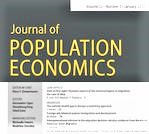A new GLO Discussion Paper confirms a strong relationship between exposure to technological risk and support for social safety nets among men but not for women.
The Global Labor Organization (GLO) is an independent, non-partisan and non-governmental organization that functions as an international network and virtual platform to stimulate global research, debate and collaboration.
GLO Discussion Paper No. 833, 2021
Technology, risk and social policy. An empirical investigation – Download PDF
by Guarascio, Dario & Sacchi, Stefano
GLO Fellow Dario Guarascio
Author Abstract: This paper investigates the role of exposure to technological risk in shaping social policy preferences, specifically on support for universal basic income and means-tested generalised minimum income. Evidence is provided for Italy, to exploit the availability of high-quality data, allowing measures of two dimensions of technological risk. Objective risk hinges upon the degree of substitutability of one’s occupation by machines, while subjective risk concerns a worker’s perception of their substitutability. We posit that exposure to technological risk induces individuals to ask for protection, and thus increases support for social policy. We test two hypotheses: first, that exposure to objective risk of replacement by machines is correlated with support for both safety nets; second, that such effect is increased by high perception of risk. On the whole, results confirm a strong relationship between exposure to technological risk and support for social safety nets, once objective risk is disentangled from subjective perceptions. However, we find that such relationship only holds for men, while it cannot be confirmed for women.

GLO Discussion Papers are research and policy papers of the GLO Network which are widely circulated to encourage discussion. Provided in cooperation with EconStor, a service of the ZBW – Leibniz Information Centre for Economics, GLO Discussion Papers are among others listed in RePEc (see IDEAS, EconPapers). Complete list of all GLO DPs – downloadable for free.
Ends;
















